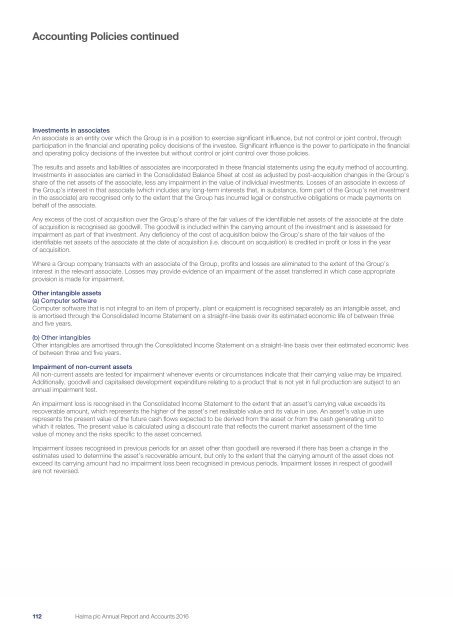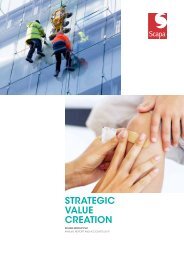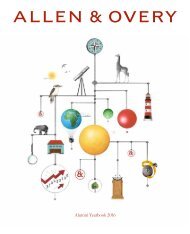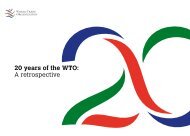You also want an ePaper? Increase the reach of your titles
YUMPU automatically turns print PDFs into web optimized ePapers that Google loves.
Accounting Policies continued<br />
Investments in associates<br />
An associate is an entity over which the Group is in a position to exercise significant influence, but not control or joint control, through<br />
participation in the financial and operating policy decisions of the investee. Significant influence is the power to participate in the financial<br />
and operating policy decisions of the investee but without control or joint control over those policies.<br />
The results and assets and liabilities of associates are incorporated in these financial statements using the equity method of accounting.<br />
Investments in associates are carried in the Consolidated Balance Sheet at cost as adjusted by post-acquisition changes in the Group’s<br />
share of the net assets of the associate, less any impairment in the value of individual investments. Losses of an associate in excess of<br />
the Group’s interest in that associate (which includes any long-term interests that, in substance, form part of the Group’s net investment<br />
in the associate) are recognised only to the extent that the Group has incurred legal or constructive obligations or made payments on<br />
behalf of the associate.<br />
Any excess of the cost of acquisition over the Group’s share of the fair values of the identifiable net assets of the associate at the date<br />
of acquisition is recognised as goodwill. The goodwill is included within the carrying amount of the investment and is assessed for<br />
impairment as part of that investment. Any deficiency of the cost of acquisition below the Group’s share of the fair values of the<br />
identifiable net assets of the associate at the date of acquisition (i.e. discount on acquisition) is credited in profit or loss in the year<br />
of acquisition.<br />
Where a Group company transacts with an associate of the Group, profits and losses are eliminated to the extent of the Group’s<br />
interest in the relevant associate. Losses may provide evidence of an impairment of the asset transferred in which case appropriate<br />
provision is made for impairment.<br />
Other intangible assets<br />
(a) Computer software<br />
Computer software that is not integral to an item of property, plant or equipment is recognised separately as an intangible asset, and<br />
is amortised through the Consolidated Income Statement on a straight-line basis over its estimated economic life of between three<br />
and five years.<br />
(b) Other intangibles<br />
Other intangibles are amortised through the Consolidated Income Statement on a straight-line basis over their estimated economic lives<br />
of between three and five years.<br />
Impairment of non-current assets<br />
All non-current assets are tested for impairment whenever events or circumstances indicate that their carrying value may be impaired.<br />
Additionally, goodwill and capitalised development expenditure relating to a product that is not yet in full production are subject to an<br />
annual impairment test.<br />
An impairment loss is recognised in the Consolidated Income Statement to the extent that an asset’s carrying value exceeds its<br />
recoverable amount, which represents the higher of the asset’s net realisable value and its value in use. An asset’s value in use<br />
represents the present value of the future cash flows expected to be derived from the asset or from the cash generating unit to<br />
which it relates. The present value is calculated using a discount rate that reflects the current market assessment of the time<br />
value of money and the risks specific to the asset concerned.<br />
Impairment losses recognised in previous periods for an asset other than goodwill are reversed if there has been a change in the<br />
estimates used to determine the asset’s recoverable amount, but only to the extent that the carrying amount of the asset does not<br />
exceed its carrying amount had no impairment loss been recognised in previous periods. Impairment losses in respect of goodwill<br />
are not reversed.<br />
112 110<br />
<strong>Halma</strong> plc Annual Report and Accounts <strong>2016</strong>

















